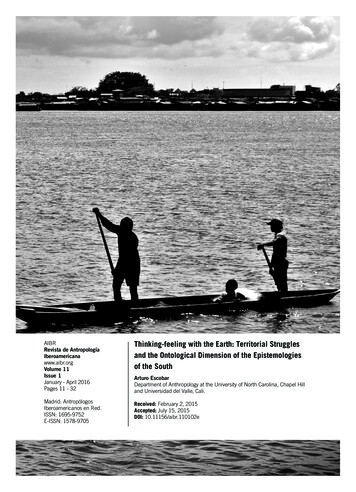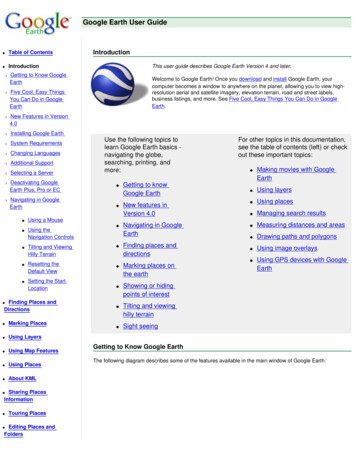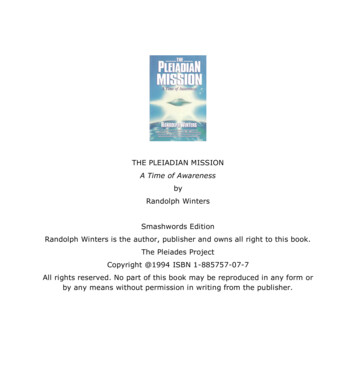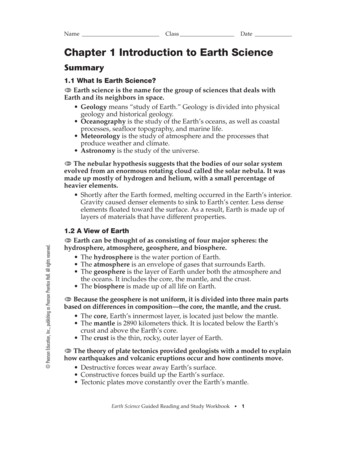
Transcription
aibrRevista de AntropologíaIberoamericanawww.aibr.orgVolume 11Issue 1January - April 2016Pages 11 - 32Thinking-feeling with the Earth: Territorial Strugglesand the Ontological Dimension of the Epistemologiesof the SouthMadrid: AntropólogosIberoamericanos en Red.ISSN: 1695-9752E-ISSN: 1578-9705Received: February 2, 2015Accepted: July 15, 2015DOI: 10.11156/aibr.110102e10 VOL11 1 ART 1 INGLES.indd 11Arturo EscobarDepartment of Anthropology at the University of North Carolina, Chapel Hilland Universidad del Valle, Cali.12/04/16 12:10
12Thinking-feeling with the Earthabstract:The theoretical framework of Epistemologies of the South was proposed by Boaventura deSousa Santos as a way to recognize other different manners to understand the World. Thisoffers a much more relevant role to non-Western views about our existence. Under thisframework the present article describes the concept of relational ontologies, which impliesdifferent theoretical fundamentals for those who no longer want to be complicit with thesilencing of popular knowledges and experiences by Eurocentric knowledge. Responding tothe monolithic idea of World or Universe, this article presents a transition towards the zapatist inspiration of pluriverse, a world where many words fit. The article describes severalexamples of indigenous reactions against the mining practices, which were extended intothe ontological occupation of the land. This article also argues that the knowledge offeredby the Epistemologies of the South is much deeper for the context of social transformationthan the one that usually originates in the academy.Key words:Epistemologies of the South, relational ontologies, social transformation, pluriverse.10 VOL11 1 ART 1 INGLES.indd 1212/04/16 12:10
13ARTURO ESCOBARIntroduction: Other knowledges, other worldsEpistemologies of the South is in all likelihood the most compelling andpracticable framework for social transformation to emerge at the intersection of the Global North and the Global South, theory and practice,and the academy and social life in many decades. Its reflexivity about itsown location, limits and potentialities is a strength of the framework. Toparaphrase its author, it is a proposal that constructs passages betweenthe No longer and the Not Yet of critical theory if not thought itself. Itdoes not claim to have arrived at a new land of general theories and BigIdeas —in fact, this is explicitly not one of its goals— yet at the same timeit dares to outline trajectories for thinking otherwise, precisely because itcarves a space for itself that enables thought to re-engage with life and attentively walk along the amazing diversity of forms of knowledge held bythose whose experiences can no longer be rendered legible by Eurocentricknowledge in the academic mode, if they ever were. The Epistemologiesof the South framework provides workable tools for all those of us whono longer want to be complicit with the silencing of popular knowledgesand experiences by Eurocentric knowledge, sometimes performed even inthe name of allegedly critical and progressive theory. The Epistemologiesof the South might also be useful to those who have been at the receivingend of those colonialist categories that have transmogrified their experiences, translated them into lacks, or simply rendered them utterly illegible and invisible.In identifying the infinite diversity of the world as one of its basicpremises, the Epistemologies of the South framework (ES) clearly takes onan ontological dimension. By this I mean that in speaking about knowledges, the ES framework is also speaking about worlds. Simply said, multiple kowledges, or epistemes, refer to multiple worlds, or ontologies. Theaim of this article is to draw out further the ontological dimension of ESby setting it in to dialogue with certain trends in contemporary criticaltheory that share with ES its fundamental ethical-political orientation oflearning at least as much from the experience, knowledge, and strugglesof subaltern social groups as from the academy. These trends –broadlyencompassed within a field that we will call “political ontology”—stemfrom the proposition that many contemporary struggles for the defenseof territories and difference are best understood as ontological strugglesand as struggles over a world where many words fit, as the Zapatista putit; they aim to foster the pluriverse. What this ontological angle adds toour understanding of contemporary struggles will become clear as theargument is developed.10 VOL11 1 ART 1 INGLES.indd 1312/04/16 12:10
14Thinking-feeling with the EarthPart I of the article offers some general remarks on the ontologicalcharacter of ES, building on some of its key premises. Part II provides anintuitive introduction to the concept of relationality and “relational ontologies” by engaging readers in an imagination exercise that asks themto situate themselves within a complex river landscape in a Colombianrainforest. Part III outlines the framework for the political ontologyof territorial struggles in Latin America; this framework is developedfrom a reinterpretation of the defense of their territories by indigenous,Afrodescendant, and peasant groups, particularly against large-scale mining and agro-fuels projects. It argues that these extractivist projects canbe seen as strategies for the ontological occupation of the territories, andhence that struggles against them constitute veritable ontological struggles. Part IV, finally, engages in a reversal that is well-known to the ESframework: it suggests that the knowledges connected with these struggles are actually more sophisticated and appropriate for thinking aboutsocial transformation than most forms of knowledge produced withinthe academy at present. This is so for two main reasons: first, because theknowledges produced from territorial struggles provide us with essentialelements for thinking about the profound cultural and ecological transitions needed to face the inter-related crises of climate, food, energy, poverty, and meaning; and second, because these knowledges are uniquelyattuned to the needs of the Earth. As the article’s title suggests, thosewho produce them sentipiensan con la Tierra (they think-feel with theEarth); they orient themselves towards that moment when humans andthe planet can finally come to co-exist in mutually enhancing manners.1I. The ontological dimension of the Epistemologiesof the SouthThe ES framework is based on a series of premises and strategies, ofteneffectively summarized by its author in compact and seemingly straightforward formulations –insightful formulas or radical reversals-- whichnevertheless point at crucial problems within contemporary theory1. The terms sentipensar and sentipensamiento are reported by Colombian sociologist Orlando Fals Borda (1984) as the living principle of the riverine and swamp communities ofColombia’s Caribbean coast. They imply the art of living based on thinking with both heartand mind. See http://www.youtube.com/watch?v LbJWqetRuMo. Sentipensamiento waslater on popularized by the Uruguayan writer Eduardo Galeano as the ability found amongpopular classes to act without separating mind and body, reason and emotion (see, e.g.,http://www.youtube.com/watch?v wUGVz8wATls).10 VOL11 1 ART 1 INGLES.indd 1412/04/16 12:10
15ARTURO ESCOBAR(Santos 2002, 2007, 2014).2 Perhaps the best starting point for our purposes here is the saying that the contemporary conjuncture is best characterized by the fact that we are facing modern problems for which thereare no longer modern solutions. Ontologically speaking, one may saythat the crisis is the crisis of a particular world or set of world-makingpractices, the world that we usually refer to as the dominant form ofEuro-modernity (capitalist, rationalist, liberal, secular, patriarchal, white,or what have you). Adopting John Law’s (2011) compact formulation,we will refer to this world as the One-World World (OWW), that is, aworld allegedly made up of a single Word, and that has arrogated foritself the right to be “the” world, subjecting all other worlds to its ownterms or, worse, to non-existence; this is a World where only a world fits.If the crisis is then caused by this OWW, it follows that facing the crisisimplies transitions towards its opposite, that is, towards the pluriverse.This is precisely what one of the major premises of ES underscores, instating that the diversity of the world is infinite; succinctly, the world ismade up of multiple worlds, multiple ontologies or reals that are far frombeing exhausted by the Eurocentric experience or reducible to its terms.The invisibility of the pluriverse points at one of major concepts of ES,namely, the sociology of absences. Here again we find an insightful epistemological formulation: what doesn’t exist is actively produced as nonexistent or as non-credible alternative to what exists. The social productionof non-existence points at the effacement of entire worlds trough a set ofepistemological operations concerning knowledge, time, productivity, andways of thinking about scale and difference. As we shall see in the nextsection, the worlds so effaced are characterized by relational ways of beingthat challenge, and actually do not abide by, the epistemological operationsthat effect absences. Conversely, the proliferation of struggles in defenseof territory and cultural difference suggests that what emerges from suchstruggles are entire worlds, which we will call relational worlds or ontologies. There are clear ontological dimensions to the two main strategiesintroduced by ES, namely, the sociology of absences (the production ofnon-existence points at the non-existence of worlds, and often implies theirontological occupation), and the sociology of emergences (the enlargementof those experiences considered valid or credible alternatives to what existentails the forceful emergence of relational worlds through struggles).2. In what follows I use a number of ES formulations from various sources; I have amendedthem slightly in some cases, which is why I do not include them as exact quotes. This section is not intended as a comprehensive or systematic presentation of ES; rather, I highlighta few of its principles that will allow me to underscore the ontological implications of theframework.10 VOL11 1 ART 1 INGLES.indd 1512/04/16 12:10
16Thinking-feeling with the EarthFinally, there are some principles of ES that point at the connectionbetween the production of theory and ontology. The first is that the understanding of the world is much broader than the western understandingof the world. This means that the transformation of the world, and thetransitions to the pluriverse or the civilizations transitions adumbratedby many indigenous, peasant, and Afrodescendant activists, might happen (indeed, are happening) along pathways that might be unthinkablefrom the perspective of Eurocentric theories. Said differently, there is aglaring gap between what most Western theories today can glean fromthe field of social struggles, on the one hand, and the transformative practices actually going on in the world, on the other. This gap is increasinglyclear; it is a limit faced by mainstream and Left theories alike, stemmingfrom the mono-ontological or intra-European origin of such theories. Tothink new thoughts, by implication, requires to move out of the epistemicspace of Western social theory and into the epistemic configurations associated with the multiple relational ontologies of worlds in struggle. Itis in these spaces that we might also find more compelling answers to thestrong questions posed by the current conjuncture. As this article willargue, in parallel to ES, sources of novel theoretical-political projects doexist, but they are more likely to be found at present in the knowledges,practices, and strategies of subaltern actors as they mobilize in defense oftheir relational worlds.3II.Yurumanguí: introducing the relational worldsPicture a seemingly simple scene from one of the many rivers that flowfrom the Western Andean mountain range towards the Pacific Oceanin Colombia’s southern Pacific rainforest region, inhabited largely byAfrodescendant communities, such as the Yurumanguí river4: a father3. Santos describes the gap between Western theory and subaltern experience as the phantasmal relation between theory and practice. He makes clear that at its most fundamental,this distance is also an ontological distance involving “ontological conceptions of being andliving [that] are quite distinct from Western individualism” (2012: 50). These conceptions iswhat we will call “relational ontologies” in the next section. In a similar vein, Santos takesa clear stand for what he calls “rearguard theories,” that is, the theoretical-political workthat goes on in the transformative work of social movements. We couldn’t agree more (see,e.g., Escobar 2008 for a similar claim).4. The Yurumanguí river is one of five rivers that flow into the bay of Buenaventura in thePacific Ocean, with a population of about 6,000 people, largely Afrodescendants. In 1999,thanks to active local organizing, the communities succeeded in securing the collective titleto about 52,000 hectares (82% of the river basin). Armed conflict, the pressure from illegalcrops, and mega development projects in the Buenaventura area, however, have militated10 VOL11 1 ART 1 INGLES.indd 1612/04/16 12:10
17ARTURO ESCOBARand his six-year old daughter paddling with their canaletes (oars) seemingly upstream in their potrillos (local dugout canoes) at the end of theafternoon, taking advantage of the rising tide; perhaps they are returninghome after having taken their harvested plantains and their catch of theday to the town downstream, and bringing back some items they boughtat the town store –unrefined cane sugar, cooking fuel, salt, notebooks forthe children, or what have you. On first inspection, we may say that thefather is ‘socializing’ his daughter into the correct way to navigate thepotrillo, an important skill as life in the region greatly depends on theceaseless going back and forth in the potrillos through rivers, mangrovesand estuaries. This is correct in some ways; but something else is alsogoing on; as locals are wont to say, speaking of the river territory, acánacimos, acá crecimos, acá hemos conocido qué es el mundo (here wewere born, here we grew up, here we have known what the world is).Through their nacer crecer conocer they enact the manifold practicesthrough which their territories/worlds have been made since they becamelibres (i.e., free, not enslaved peoples) and became entangled with livingbeings of all kinds in these forest and mangrove worlds.Let us travel to this river and immerse ourselves deeply within it andexperience it with the eyes of relationality; an entire way of worldingemerges for us. Looking attentively from the perspective of the manifoldrelations that make this world what it is, we see that the potrillo wasmade out of a mangrove tree with the knowledge the father received fromhis predecessors; the mangrove forest is intimately known by the inhabitants who traverse with great ease the fractal estuaries it creates withthe rivers and the always moving sea; we begin to see the endless connections keeping together and always in motion this inter-tidal ‘aquaticspace’ (Oslender 2008), including connections with the moon and thetides that enact a non-linear temporality. The mangrove forest involvesmany relational entities involving what we might call minerals, mollusks,nutrients, algae, microorganisms, birds, plant, and insects -- an entire assemblage of underwater, surface, and areal life. Ethnographers of theseworlds describe it in terms of three non-separate worlds (el mundo deabajo or infraworld; este mundo, or the human world; and el mundo dearriba, or spiritual/supraworld). There are comings and goings betweenthese worlds, and particular places and beings connecting them, including ‘visions’ and spiritual beings (e.g., Restrepo 1996). This entire worldis narrated in oral forms that include storytelling, chants and poetry.against the effective control of the territory by locals. Nevertheless, the collective title implied a big step in the defense of their commons and the basis for autonomous territoriesand livelihoods.10 VOL11 1 ART 1 INGLES.indd 1712/04/16 12:10
18Thinking-feeling with the EarthThis dense network of interrelations may be called a ‘relational ontology’. The mangrove-world, to give it a short name, is enacted minuteby minute, day by day, through an infinite set of practices carried out byall kinds of beings and life forms, involving a complex organic and inorganic materiality of water, minerals, degrees of salinity, forms of energy(sun, tides, moon, relations of force), and so forth. There is a rhizome‘logic’ to these entanglements, a ‘logic that is impossible to follow in anysimple way, and very difficult to map and measure, if at all; it reveals analtogether different way of being and becoming in territory and place.These experiences constitute relational worlds or ontologies. To put it abstractly, a relational ontology of this sort can be defined as one in whichnothing preexist the relations that constitute it. Said otherwise, thingsand beings are their relations, they do not exist prior to them.As the anthropologist Tim Ingold says (2011: 131), these “worldswithout objects” are always in movement, made up of materials in motion, flux and becoming; in these worlds, living beings of all kinds constitute each other’s conditions for existence; they “interweave to form animmense and continually evolving tapestry” (p. 10). Going back to theriver scene, one may say that ‘father’ and ‘daughter’ get to know their local world not through distancing reflection but by going about it, that is,by being alive to their world. These worlds do not require the divide between nature and culture in order to exist –in fact, they exist as such onlybecause they are enacted by practices that do not rely on such divide. Ina relational ontology, “beings do not simply occupy the world, they inhabit it, and in so doing –in threading their own paths through the meshwork—they contribute to their ever evolving weave” (p. 71). Commonsexist in these relational worlds, not in worlds that are imagined as inertand waiting to be occupied.Even if the relations that keep the mangrove-world always in a stateof becoming are always changing, to mess up significantly with themoften results in the degradation of such worlds. Such is the case with industrial shrimp farming schemes and oil palm plantations for agro-fuels,which have proliferated in tropical regions in many parts of the world,often built at the expense of mangrove and humid forest lands, with theaim to transform them from ‘worthless swamp’ to agro-industrial complexes (Ogden 2010). Here, of course, we find many of the operations ofthe One-World world (OWW) at play: the conversion of everything thatexists in the mangrove-world into ‘nature’ and ‘nature’ into ‘resources’;the effacing of the life-enabling materiality of the entire domains of theinorganic and the non-human, and its treatment as ‘objects’ to be had,destroyed, or extracted; and linking the forest worlds so transformed to10 VOL11 1 ART 1 INGLES.indd 1812/04/16 12:10
19ARTURO ESCOBAR‘world markets’ for profit. In these cases, the insatiable appetite of theOne-World world spells out the progressive destruction of the mangroveworld, its ontological capture and reconversion by capital and the State(Deleuze and Guattari 1987; Escobar 2008). The OWW, in short, deniesthe mangrove-world its possibility of existing as such. Local strugglesconstitute attempts to re/establish some degree of symmetry to the partialconnections that the mangrove-worlds maintain with the OWW.III. Territoriality, ancestrality, worlds: outline of politicalontology.Elders and young activists in many territorial communities worldwide (including increasingly in urban areas) eloquently express why they defendtheir worlds even at the price of their lives. In the words of an activist fromthe Afrodescendant community of La Toma, also in Colombia’s southwest,engaged in a struggle against gold mining since 2008, “It is patently clear tous that we are confronting monsters such as transnational corporations andthe State. Yet nobody is willing to leave her/his territory; I might get killedhere but I am not leaving.”5 Such resistance takes place within a long historyof domination and resistance, and this is essential for understanding territorial and commons defense as an ontological political practice. La Tomacommunities, for instance, have knowledge of their continued presence inthe territory since the first half of the XVII century. It’s an eloquent example of what activists call ‘ancestrality,’ referring to the ancestral mandatethat inspires today’s struggles and that persists in the memory of the elders,amply documented by oral history and scholars (Lisifrey et al. 2013). Thismandate is joyfully celebrated in oral poetry and song: Del Africa llegamoscon un legado ancestral; la memoria del mundo debemos recuperar (“FromAfrica we arrived with an ancestral legacy; the world’s memory we need torecuperate”).6 Far from an intransigent attachment to the past, ancestralitystems from a living memory that orients itself to the ability to envision adifferent future –a sort of “futurality” that imagines, and struggles for, theconditions that will allow them to persevere as a distinct world.75. Statement by Francia Marquez of the Community Council of La Toma, taken from thedocumentary La Toma, by Paula Mendoza, accessed May 20, 2013, http://www.youtube.com/watch?v BrgVcdnwU0M. Most of this brief section on La Toma comes from meetings in which I have participated with La Toma leaders in 2009, 2012, and 2014, as wellas campaigns to stop illegal mining in this ancestral territory and the March to Bogotá ofNovember, 2014.6. From the documentary by Mendoza cited above.7. I borrow the term futurality from Australian designer Tony Fry (2012)10 VOL11 1 ART 1 INGLES.indd 1912/04/16 12:10
20Thinking-feeling with the EarthWithin relational worlds, the defense of territory, life, and the commons are one at the same. To this extent, this article’s argument can bestated as follows: The perseverance of communities, commons, and thestruggles for their defense and reconstitution – particularly, but not only,those that incorporate explicitly ethno-territorial dimensions— involvesresistance and the defense and affirmation of territories that, at their bestand most radical, can be described as ontological. Conversely, whereasthe occupation of territories by capital and the State implies economic,technological, cultural, ecological, and often armed aspects, its most fundamental dimension is ontological. From this perspective, what occupiesterritories is a particular ontology, that of the universal world of individuals and markets (the OWW) that attempts to transform all otherworlds into one. By interrupting the neoliberal globalizing project ofconstructing One World, many indigenous, Afrodescendant, peasant, andpoor urban communities are advancing ontological struggles. The struggle to maintain multiple worlds –the pluriverse—is best embodied by theZapatista dictum, un mundo donde quepan muchos mundos, a worldwhere many worlds fit. Many of these worlds can thus be seen as engagedin struggles over the pluriverse.Another clear case of ontological occupation of territories comesfrom the southernmost area in the Colombian Pacific, around the portcity of Tumaco. Here, since the early 1980s, the forest has been destroyedand communities displaced to give way to oil palm plantations. Inexistentin the 1970s, by the mid-1990s they had expanded to over 30,000 hectares. The monotony of the plantation –row after row of palm as far asyou can see, a green desert of sorts-- replaced the diverse, heterogeneousand entangled world of forest and communities. There are two importantaspects to remark from this dramatic change: first, the ‘plantation form’effaces the relations maintained by the forest-world; emerging from adualist ontology of human dominance over so-called ‘nature’ understoodas ‘inert space’ or ‘resources’ to be had, the plantation can thus be said tobe the most effective means for the ontological occupation and ultimateerasure of local relational worlds. In fact, plantations are unthinkablefrom the relational perspective of forest-worlds; within this world, forestutilization and cultivation practices take on an entirely different formthat ecologists describe in terms of agro-ecology and agro-forestry; eventhe landscape, of course, is entirely different. Not far from the oil palmplantations, as it was already mentioned, industrial shrimp companieswere also busy in the 1980s and 1990s transforming the mangrove-worldinto disciplined succession of rectangular pools, ‘scientifically’ controlled.A very polluting and destructive industry especially when constructed on10 VOL11 1 ART 1 INGLES.indd 2012/04/16 12:10
21ARTURO ESCOBARmangrove swamps, this type of shrimp farming constitutes another clearexample of ontological occupation and politics at play (Escobar 2008).One of the main frameworks proposed for understanding the occupation of territories and resistance to such occupation is that of politicalontology (Blaser 2010, 2014). On the one hand, political ontology refersto the power-laden practices involved in bringing into being a particular world or ontology; on the other hand, it refers to a field of studythat focuses on the inter-relations among worlds, including the conflictsthat ensue as different ontologies strive to sustain their own existencein their interaction with other worlds. This framework links conversations in critical theory (particularly in indigenous studies and Science andTechnology Studies, STS) with momentous developments in socionaturallife (e.g., Latin American indigenous uprisings and struggles). The spacecrafted by researchers at this intersection is particularly hopeful to illuminate effective paths towards the planet’s ontological reconstitution(de la Cadena 2010, in press). It should be stressed, however, that thisframework is not limited to ethnic minority territories. In different ways,it applies to all social groups world-wide, including to the ontological occupation of popular neighborhoods in many of the world’s urban areas.8Political ontology also helps us to understand the persistence of theoccupying ontologies. Although taken as the common sense understanding of “the way things are,” the One-World world is the result of particular practices and historical choices. A crucial moment in the emergenceof such practices was the Conquest of America, which some considerthe point of origin of our current modern/colonial world system (e.g.,Mignolo 2000). Perhaps the most central feature of the One-World project has been a twofold ontological divide: a particular way of separating humans from nature (the nature/culture divide); and the distinctionand boundary policing between those who function within the OWWfrom those who insist on other ways of worlding (the colonial divide).These (and many other derivative) dualisms underlie an entire structureof institutions and practices through which the OWW is enacted. Thereare many signs, however, that suggest that the One-World doctrine isunraveling. The ubiquity of the language of crisis to refer to the planetaryecological and social condition (chiefly, but well beyond, global climatechange) heralds this unraveling. The growing visibility of struggles todefend mountains, landscapes, forests, territories and so forth by appealing to a relational (non-dualist) and pluri-ontological understanding of8. How not to understand the situation in Ferguson, Missouri; Detroit, Michigan; Buenaventura in the Colombian Pacific; or of so many ethnic minority quarters in the bigcapitals of the Global North but as ontological (often ontological-military)occupations?10 VOL11 1 ART 1 INGLES.indd 2112/04/16 12:10
22Thinking-feeling with the Earthlife is another manifestation of the OWW’s crisis. Here we find a clearinstantiation of Santos’ paradox that we are facing modern problemsfor which there are no longer sufficient modern solutions. The crisis thusstems from the models through which we imagine the world to be a certain way and construct it accordingly.The unraveling of the OWW fosters momentous questions for bothsocial theory and political activism on behalf of territories: How did the‘One-World world’ become so powerful? How does it work today? Howis it made and unmade? Can it be rearticulated in terms of a plurality ofworlds? (Law 2004, 2011; Law and Lien 2012; Blaser, de la Cadena, andEscobar 2014). These are key questions for a pluriversal ontological politics. This conjuncture and questions define a rich context for political ontology and ‘pluriversal studies’: on the one hand, the need to understandthe conditions by which the OWW continues to maintain its dominance;on the other, the emergence of projects based on different ontologicalcommitments and ways of worlding, including commoning (e.g., Nonini,ed. 2007; Bollier 2014; Bollier and Helfrich, eds. 2012), and how theystruggle to weaken the One-world project while widening their spaces ofre/existence.The ‘pluriverse’ is a way of looking at reality that contrasts withthe OWW assumption that there is a single reality to which there correspond multiple cultures, perspectives, or subjective representations. Forthe pluriverse proposal, there are multiple reals, yet it is not intended to‘correct’ the view on a single real on the grounds of being a truer accountof ‘reality.’ The pluriverse is a tool to first, make alternatives to the oneworld plausible to one-worlders, and, second, provide resonance to thoseother worlds that inter
Thinking-feeling with the Earth: Territorial Struggles and the Ontological Dimension of the Epistemologies of the South Arturo Escobar Department of anthropology at the University of North Carolina, Chapel Hill and Universidad del Valle, Cali. Received: February 2, 2015 Accepted: July 15, 2015 DOI: 10.11156/aibr.110102e










